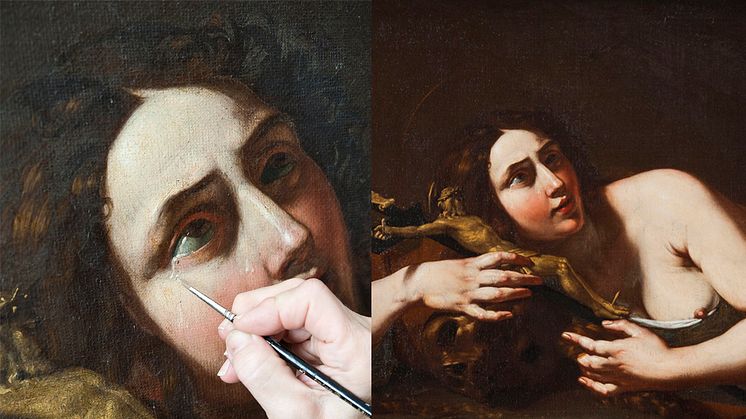
Press release -
The conservation of The Penitent Mary Magdalene
The Penitent Mary
Magdalene has not been on view for a long time due to the painting’s poor
condition. Last year thorough conservation work was carried out to remove
layers of dirt and discolourations. After 200 hours of work, it is once again
possible to enjoy the many exquisite details. The painting will be on view as
part of the exhibition The Masters of
Darkness until March 30.
The painting The Penitent Mary Magdalene has been in the museum’s collection for a long time, but has not been on view in the museum for decades due to the poor condition it was in. It was hidden under thick layers of dirt and yellowed varnish and there were older, discoloured retouches from earlier restorations. In the course of a research project involving the museum’s Italian paintings collection, the work was examined in 2011 by Britta Nilsson, an art conservator at Nationalmuseum. After an initial cleaning test it was clear that the painting had high artistic value. During 2013 a thorough conservation was carried out and the painting is now on view in the exhibition Masters of Darkness in Nationalmuseum’s temporary venue at the Royal Swedish Academy of Fine Arts.
Another reason for the work’s new-found prominence is the fact that we now know a lot more about the group of painters to which the artist belonged. He was long known simply as Cecco del Caravaggio, pupil of the great Caravaggio. Lately some researchers have identified him as the artist Francesco Boneri. Boneri lived in Rome in the early 17th century and painted altarpieces for churches as well as easel paintings for private art collectors with religious as well as profane motifs.
The Penitent Mary Magdalene was probably a private commission. It arrived in Sweden in 1804 as a result of a government purchase from Nicola Martelli, a Rome art dealer. For many years it hung in Kalmar Castle on deposit from Nationalmuseum. The work is painted on a coarse linen canvas prepared with a thin, reddish ground layer. After this, the artist applied a thin, dark-brown primer over the entire surface before painting the figure. The primer is used to heighten the contrast between light and dark. Thinly painted, semi-transparent areas of shadow stand out against pastose, solid areas of paint. An example of the latter is the paint used for skin tones, which has a high white-lead content.
The artist made his own oil paints by mixing pulverized pigment with linseed oil. For Mary Magdalene’s brown cloak, he used an organic earth tone such as ochre or brown umber. The sleeves of her blue dress are painted in azurite, a mineral pigment that has degraded over time and lost its original intensity. The skin tones are fairly thickly painted, with brush strokes clearly visible in the most pastose areas. The facial details are surprisingly well preserved – for instance, the red paint on the subject’s lips and cheeks. In her hair we can make out thin brush strokes that emphasize her flowing curls.
To begin the process of conserving the painting, the surface dirt was first removed using distilled water. After this, it was possible to see where the original paint had lifted or flaked slightly. This was especially true of the brown earth tones in Mary Magdelene’s cloak. The paint was stabilized by using isinglass (sturgeon glue) and a heated spatula. Only then could the heavily yellowed varnish be removed, millimetre by millimetre, using a solvent that did not affect the original paint. Oil paintings over 400 years old are relatively robust and can withstand fairly strong solvents. Older, discoloured retouches were also removed. A scalpel was used to scrape away any residual dirt and varnish from indentations in the paint surface. The pin-sized spots where the paint had flaked were cemented and touched up, so that they were no longer visible to the naked eye. For the touch-ups watercolour paints were used that can be removed if necessary with no risk of damaging the original paint.
After 200 hours of conservation work, we can once again enjoy the many exquisite details in the painting; the saint’s sensitively painted skin and her almost transparent tears and the light from the artist’s studio window reflected in the little glass bottle.
Link to a short movie about the conservation of The Penitent Mary Magdalene: http://vimeo.com/83576316
The exhibition The Masters of Darkness runs until March 30, 2014 in Nationalmuseum’s temporary venue at the Royal Swedish Academy of Fine Arts, Fredsgatan 12 in Stockholm.
Further information
Carina Fryklund, Curator, Department of Collections and
Swedish National Portrait Gallery
carina.fryklund@nationalmuseum.se, +46 8
5195 4475
Hanna Tottmar, press officer, hanna.tottmar@nationalmuseum.se, +46 767 23 46 32
Caption
Cecco del Caravaggio (Francesco Boneri), The Penitent Mary Magdalene. Photo: Anna
Danielsson/Nationalmuseum.
Nationalmuseum is Sweden’s premier museum of art and design. The collections comprise older paintings, sculpture, drawings and graphic art, and applied art and design up to the present day. The museum building is currently under renovation and scheduled to open again in 2017. In the meantime, the museum will continue its activities through collaborations, touring exhibitions and a temporary venue at the Royal Swedish Academy of Fine Arts, Fredsgatan 12, Stockholm. Nationalmuseum collaborates with Svenska Dagbladet, Fältman & Malmén and Grand Hôtel Stockholm. For more information visit www.nationalmuseum.se.

